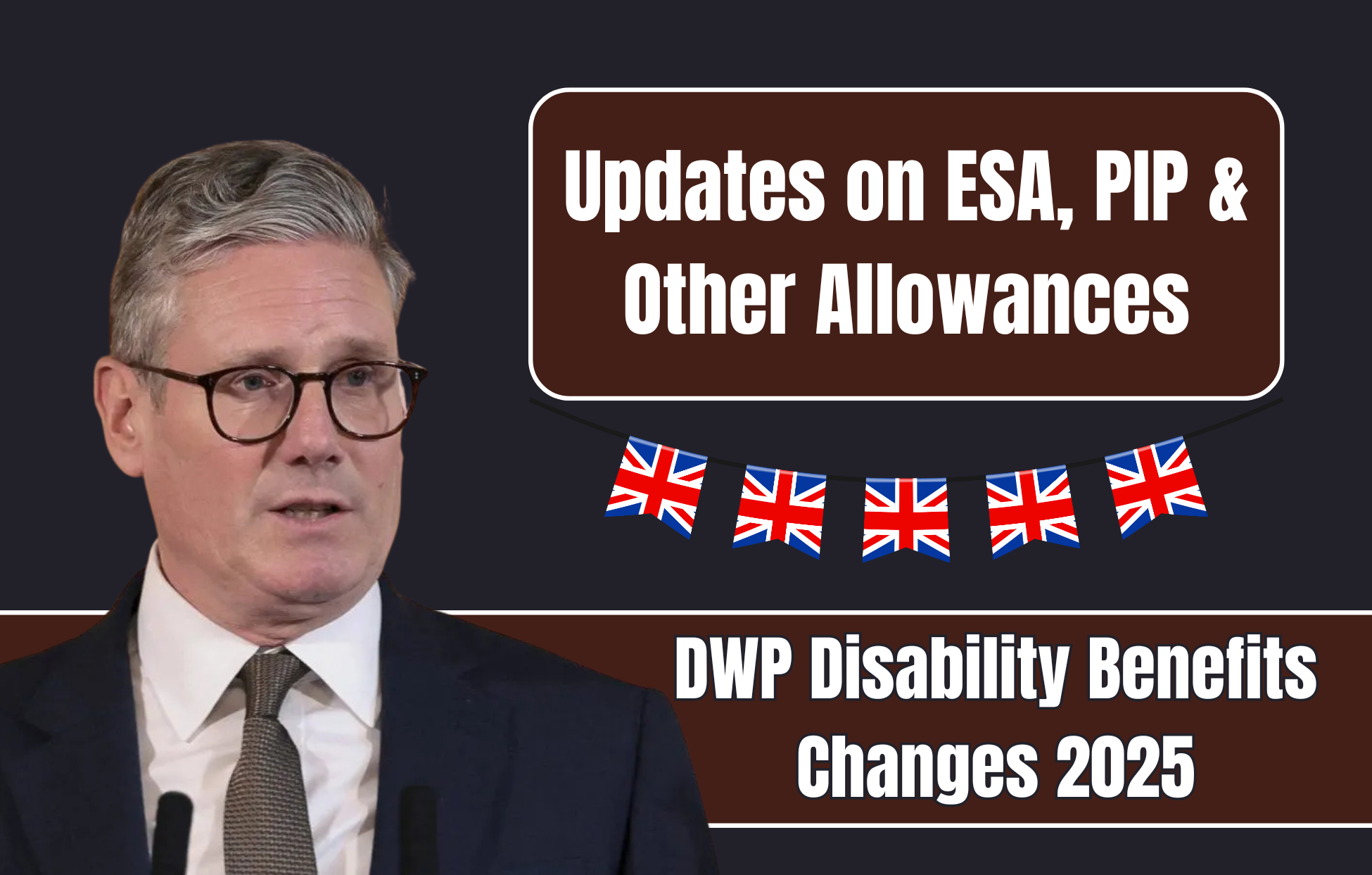DWP Disability Benefits 2025: What’s Changing for ESA, PIP & Allowances
The Department for Work and Pensions (DWP) is undertaking sweeping reforms to health‑ and disability‑related benefits as part of its Pathways to Work welfare reform agenda. These changes are driven by rising costs of disability support, pressure on benefit expenditure, and a political push for sustainability in the welfare system.
Some changes are already enacted, such as benefit uplifts, while others are proposed for 2025–2026 and beyond. Many reforms will phase in over time, and in some cases only apply to new claimants or those being reassessed.
This article explains what’s changing with ESA, PIP, the health element in Universal Credit, and related allowances—and what claimants and carers should watch out for.
Employment and Support Allowance (ESA) & Work Capability Assessment
ESA provides support for people who are ill or disabled and unable to work. It has two components: contribution‑based ESA and income‑related ESA (for those with limited income/savings). In 2025, ESA has been uprated by about 1.7% to help offset inflation. ESA claimants are categorized into groups:
- Work-Related Activity Group (WRAG): for those expected to take steps toward work
- Support Group: for those with more severe conditions who are not required to prepare for work
Proposed Reforms & Future Changes

One proposal is to merge ESA with New Style Jobseeker’s Allowance (JSA) into a new, time-limited “Unemployment Insurance” benefit, though details remain uncertain.
The Work Capability Assessment (WCA), which determines eligibility and classification, is expected to be phased out by 2028 and replaced by a unified assessment based on PIP criteria. Reassessments of existing ESA claimants will be reintroduced in many cases, except in situations involving terminal illness or certain exemptions.
Although the current ESA structure remains, the assessment process may shift to align more closely with PIP’s framework.
What Claimants Should Do
- Keep medical evidence up to date and document how your condition affects daily living and ability to work.
- Be aware that future assessments may focus more on how disabilities impact daily tasks, not just your capacity to work.
- If you’re in the WRAG, engage with work-preparation schemes or support services when required.
Personal Independence Payment (PIP)
PIP is a key non-means-tested benefit for people aged 16 to State Pension age. It is designed to help with extra costs arising from long-term health conditions or disabilities.
In 2025, PIP components were increased by approximately 1.7% to help keep pace with inflation. The benefit structure remains with two components: Daily Living and Mobility, each with standard and enhanced rates.
Proposed Eligibility Rule Changes (and Reversals)

One controversial proposal aimed to change the Daily Living component rule. Under the draft reform, claimants would need to score at least 4 points in one single daily living activity to qualify for the component. This would disqualify people whose disabilities impact multiple areas slightly but not severely in one area.
This change was projected to affect more than 370,000 existing claimants and potentially prevent 430,000 new claims, with estimated average losses of £4,500 per household annually.
However, in July 2025, the government reversed course. The proposed clause was removed from the legislation, and changes will now be reconsidered after the Timms review of PIP, expected in autumn 2026. No immediate changes will affect existing claimants.
Implementation & Safeguards
Any future changes will likely apply only to new claimants, and current PIP recipients will be protected from losing benefits due to updated criteria. Light-touch reviews for long-term claimants may also be improved to simplify reassessments.
What Claimants Should Do
- No immediate action is needed if you already receive PIP.
- If your condition changes or you’re approaching a review, ensure your evidence is up to date and reflects how your condition limits daily activities.
- Stay informed about the Timms review and how future rules might apply.
- New claimants after 2026 should review the proposed descriptor changes carefully to assess eligibility.
Universal Credit / Health Element & Carers’ Support
Many people claiming disability benefits also receive Universal Credit (UC), which includes a Health & Disability element—formerly known as Limited Capability for Work and Work-Related Activity (LCWRA).
Freeze / Cut in Health Element for New Claimants
Existing recipients of the health element will see their rate frozen at £97 per week until 2029/2030. However, from April 2026, new claimants will receive a significantly reduced rate of £50 per week, which will also remain frozen through 2029/2030.
To partially offset this, the standard allowance component of UC will see above-inflation increases over the same period. For example, single claimants over 25 will see the base allowance rise toward £106/week by 2029/30.
Carer’s Allowance & Other Disability-Linked Allowances
Carer’s Allowance has been modestly increased to approximately £83.30 in 2025. The earnings threshold for eligibility has also risen to around £196 per week.
Attendance Allowance for those over State Pension age who need care has been increased, as have Disability Living Allowance (DLA) rates for children and legacy claimants.
Interplay Between PIP & UC Health Element
The government has proposed linking the UC health element more closely to PIP. In future, only individuals receiving the PIP Daily Living component may qualify for the UC health element. This is part of a broader move to eliminate the WCA entirely by 2028, with assessments consolidated under PIP rules.
What Claimants Should Do
- New claimants from April 2026 should plan for a lower UC health element rate.
- Make sure your PIP award is active and properly reflects your current condition, as it may determine future eligibility for UC’s health component.
- If you’re transitioning between benefits or facing reassessment, budget and seek support accordingly.
Risks, Critiques & Predicted Impact

These upcoming reforms have sparked criticism and concern among disability rights groups and charities.
Advocacy groups warn that tighter PIP rules could push many disabled people out of support entirely, risking increased poverty. The projected freeze and reduction in benefits could impact hundreds of thousands of families who are already financially vulnerable.
To soften the impact, the government has proposed a three-month grace period for claimants who lose their eligibility during these transitions. However, the decision to freeze health element payments while costs continue to rise is seen by critics as a real-terms cut.
Some of the most controversial proposals have already been reversed due to public and political pressure, including the scrapping of the 4-point rule for existing PIP claimants.
Key Takeaways & What You Should Do
- Disability benefits including ESA, PIP, DLA, Attendance Allowance, and Carer’s Allowance have been modestly increased by around 1.7% for 2025.
- Structural reforms are coming, including new eligibility rules, reassessment frameworks, and reduced UC health element for new claimants.
- Current claimants are protected in many cases, but changes may apply during future reassessments or to new applicants.
- Major policy reviews, such as the Timms review of PIP, are expected by late 2026 and could shape long-term rules.
- Stay informed, document your medical condition thoroughly, and seek support if facing changes or reassessments.
FAQs
1. What disability benefits are changing in 2025?
ESA, PIP, Universal Credit (health element), Carer’s Allowance, and Attendance Allowance are all impacted—some with rate increases, others with major eligibility or structural reforms proposed for 2026 onward.
2. Has ESA changed in 2025?
Yes, ESA has been uprated by about 1.7% in 2025. However, future reforms may merge ESA with JSA or phase out the Work Capability Assessment entirely.
3. Is ESA being abolished or replaced?
Not yet. But the Work Capability Assessment (WCA) is set to be phased out by 2028 and replaced with a single assessment likely based on PIP criteria.
